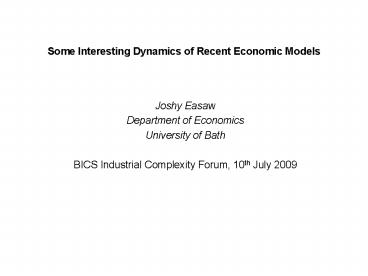Some Interesting Dynamics of Recent Economic Models - PowerPoint PPT Presentation
1 / 16
Title:
Some Interesting Dynamics of Recent Economic Models
Description:
Households' sentiments/confidence oscillates between periods of optimism' and ... Consumer sentiment - Government Competence - Target Government Competence ... – PowerPoint PPT presentation
Number of Views:74
Avg rating:3.0/5.0
Title: Some Interesting Dynamics of Recent Economic Models
1
Some Interesting Dynamics of Recent Economic
Models
- Joshy Easaw
- Department of Economics
- University of Bath
- BICS Industrial Complexity Forum, 10th July 2009
2
- Mr Keynes and Animal Spirits
- Keynes appreciated that most economic activity
results from rational economic motivations but
also that much of economic activity is governed
by animal spirits non-economic motives. - Animals spirits are the main cause of
fluctuations in aggregate economy (eg. current
housing market crisis etc.)
- Animal Spirits George Akerlof and Robert
Shiller, 2009, Princeton University Press - Households Animal Spirits Depicted by Consumer
Sentiments (or Confidence) (Akerlof and Shiller
(2009) - Households sentiments/confidence
oscillates between periods of optimism and
pessimism, affecting their consumption and
economic cycles.
3
(No Transcript)
4
- Dynamics of consumer sentiments (or confidence)
- Especially households over-reaction and
under-reaction. - Theoretical Model Psychology of Economic Voting
- The relationship between households consumer
sentiments and their view of government
competence in managing the macroeconomy. - Bankers and Peasants
5
- Intertemporal Bankers Behavior
- - Consumer sentiment
- - Government Competence
- - Target Government Competence
- Intertemporal Peasants Behavior
6
Phase Diagram Consumer Sentiments and
Government Competence
7
- Why do households form expectations about
- the macroeconomy (eg. inflation)?
- Importance of forming inflation expectations
wage negotiations and setting wage contracts. - How do households form expectations about
- the macroeconomy (eg. inflation)?
- Most likely through the news media who report the
- forecasts (or expectations) of professional
economists
8
(No Transcript)
9
- Standard/Current Model (Carroll 2003 and 2006)
Epidemiology of expectations formation - (1)
- - households inflation expectations
- - professionals inflation expectations
- - households absorption rate
10
Easaw and Ghoshrays Easaw and Golinellis
extended model
- i. Active Households inflation expectations
(2)
- active households inflation expectations
- active households absorption rate
ii. Passive Households inflation expectations
(3)
- proportion passive household observes active
household
(4)
- passive households absorption rate of either
professionals or actives expectations
Empirical Results General public (passive
learners) learns partly via the professionals and
partly via trade unions (active learners).
11
- III Dynamics of Sticky Information Expectations
II The Case of Spatial Learning (Easaw and
Mossay (2009) - 1. Social Interaction
- Two scenarios
- First Scenario Active households partly observe
professionals forecast directly or via their
neighbors (active)- through social interaction
- active households absorption rate
- active households interaction rate
12
Second Scenario Passive households partly
observe professionals forecast indirectly via
active households or via their neighbors
(passive) - through social interaction
- passive households absorption rate
- passive households interaction rate
13
(No Transcript)
14
Spatial Convergence
- Convergence depend on both absorption and
interaction rate - The interaction rate introduces the dimension of
space to the element of time. Hence, when
learning agents are learning from neighbors
their relative inflation expectations matter.
That is the relative dispersion of their
inflation expectations Spatial Frequency. - Dynamics of Spatial Learning
- Convergence takes place but also depend on
spatial frequencies. - In the case of passive households (under certain
conditions) it overshoots initially
15
Time Path of the Active and Passive Households
Expectations
Expectations
16
(No Transcript)































